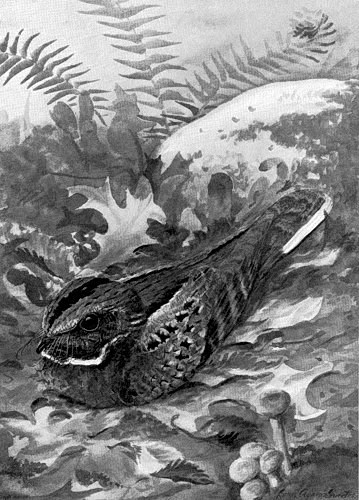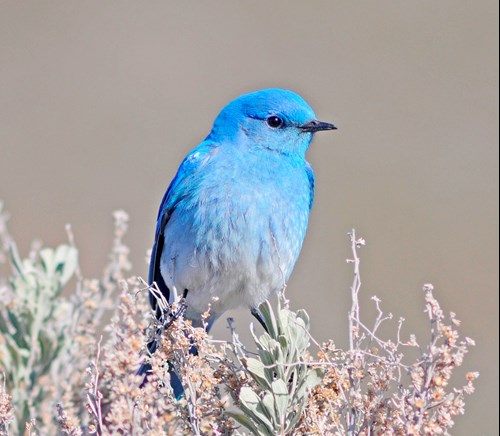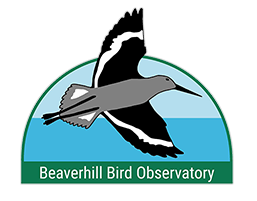Great Decline of Aerial Insectivores
Saturday, February 1, 2020Aerial Insectivores 101
The term ‘aerial insectivores’ refer to birds that feed on insects in flight. Species in this category belong to many different families including swallows, swifts, nightjars, and flycatchers. Let’s look at the Least Flycatcher as an example to learn more about this group of birds. This small bird winters in Central America and migrates north for the breeding season to occupy a vast territory that extends from the eastern coast to interior British Columbia. Breeding in deciduous forests, it weaves together a small cup nest made out of grasses, pieces of bark, and spider webs. It eats mainly insects like ants, small wasps, beetles, flies, caterpillars, and leafhoppers. Unfortunately, Least Flycatchers have suffered a 53% population decline between 1970 and 2014, with no end in sight to these dropping numbers. This finding is consistent with broader population trends among other aerial insectivores in Canada, which overall have declined by 59% in the last 50 years. In this blog, we will explore some of the causes behind this dramatic decline.
Aerial Insectivore Population Decline
Populations of aerial insectivores are declining globally due to a combination of changes in prey abundance, prey quality, climate change, and habitat loss. Aerial insectivores eat a variety of both terrestrial and aquatic insects, and unfortunately the population of insects around the world has declined sharply in recent decades. In the last 40 years, Lepidoptera (butterflies and moths) have declined by 45% globally and several populations of moths here in North America have declined dramatically over the same period. Research, however, shows that the impact of declining insect population on aerial insectivores in not so straight forward. Some species of aerial insectivores are able to cope with declining insect population by increasing foraging time, foraging intensity, and by switching to an alternative diet. Swallows, for instance, switch to eating more terrestrial insects when populations of aquatic insects decline. On the other hand, other populations of aerial insectivores, like the Whip-poor-will (a nightjar), are affected more severely by declining insect populations. More research is needed to fully understand this relationship, yet the overall decline in aerial insectivores’ food supply remains a matter of serious concern.
Researchers have also found a decline in insect quality due to the pesticides we are using. Toxic pesticides used by humans on our crops and gardens, can accumulate lower in the food chain, in our aquatic and terrestrial insects. Aerial insectivores that feed on pesticide contaminated insects can suffer from suppression of growth and development, low productivity, damaged immune system, and can even die. A study on Acadian Flycatchers showed that due to the presence of mercury, a toxin that came from contaminated insects they ate, these birds suffered from lower reproductive success. Similarly, neonicotinoids, a class of pesticides heavily used here in North America, contaminates terrestrial insects, and studies have found trace amounts of these neonicotinoids in the food consumed by Tree Swallows occupying farmland habitat. The lack of good quality prey and pesticide contaminated insects is another factor contributing to the decline of aerial insectivores.
 Lastly climate change is also impacting aerial insectivores by amplifying severe weather events, increasing nest failure rates, causing shortages in food supply, and changing the timing in bird migration. Avian insectivores across North America are arriving earlier to their breeding grounds due to warmer spring temperatures. This advancing migration, however, puts them at greater risk of suffering from severe weather events and even starvation due to lack of insect availability during that time of year. The first arrival date of Mountain Bluebirds, for example, has advanced by 19 days over the last 58 years in central Alberta due to increasing temperature. But, since April is one of the snowiest months of the year, they are at risk of suffering from cold and starvation due to heavy snow cover on the ground. In eastern Canada, Tree Swallow populations have declined over the last four decades, due to declining juvenile survival rate, caused by increasing amounts of precipitation and bad weather events during the breeding season. These unfavourable weather factors are amplified by climate change, making it harder for birds to find enough food for their young to survive.
Lastly climate change is also impacting aerial insectivores by amplifying severe weather events, increasing nest failure rates, causing shortages in food supply, and changing the timing in bird migration. Avian insectivores across North America are arriving earlier to their breeding grounds due to warmer spring temperatures. This advancing migration, however, puts them at greater risk of suffering from severe weather events and even starvation due to lack of insect availability during that time of year. The first arrival date of Mountain Bluebirds, for example, has advanced by 19 days over the last 58 years in central Alberta due to increasing temperature. But, since April is one of the snowiest months of the year, they are at risk of suffering from cold and starvation due to heavy snow cover on the ground. In eastern Canada, Tree Swallow populations have declined over the last four decades, due to declining juvenile survival rate, caused by increasing amounts of precipitation and bad weather events during the breeding season. These unfavourable weather factors are amplified by climate change, making it harder for birds to find enough food for their young to survive.
What Can We Do?
We can support our feathery friends by purchasing sustainable and organic food, produced without chemicals and pesticides. Organic produce is often available at local farmers’ markets. We can also make habitat for the insects in our own backyard by planting more native and flowering plants. You can learn more about planting gardens for insects here. Lastly, we can help stop climate change by driving less, walking and biking to places more, using public transport, and carpooling.
Picture Credit
Andy Reago and Chrissy McClarren, accessed on January 24, 2020, retrieved from https://commons.wikimedia.org/wiki/File:Least_Flycatcher_(45036879361).jpg
Whip-poor-will Drawing by Louis Agassiz Fuertes (1874 - 1972). https://commons.wikimedia.org/wiki/File:Whip-poor-will.jpg
Mountain Bluebird by VJAnderson. 7 April 2019. https://commons.wikimedia.org/wiki/File:Mountain_Bluebird_5841vv.jpg
Additional Readings
Spiller, Kimberly J., and Randy Dettmers. "Evidence for multiple drivers of aerial insectivore declines in North America." The Condor 121, no. 2 (2019): duz010. https://academic.oup.com/condor/article/121/2/duz010/5497088
Myrna Pearman, Leo De Groot, Geoffrey l. Holroyd, and Stephanie Thunberg. Earlier Spring Arrival of the Mountain Bluebird in Central Alberta, Canada. accepted 19 December, 2019
English, Philina A., Joseph J. Nocera, Bruce A. Pond, and David J. Green. "Habitat and food supply across multiple spatial scales influence the distribution and abundance of a nocturnal aerial insectivore." Landscape Ecology 32, no. 2 (2017): 343-359. English, Philina Anne. "A role for insect availability in limiting populations of a threatened nightjar Antrostomus vociferous." PhD diss., Science: Biological Sciences Department, 2017. http://summit.sfu.ca/system/files/iritems1/17176/etd10097_PEnglish.pdf
Cox, Amelia. "Population decline in an avian aerial insectivore (Tachycineta bicolor) linked to climate change." PhD diss., 2018. https://qspace.library.queensu.ca/bitstream/handle/1974/24866/Cox_Amelia_R_201709_MSC.pdf?sequence=3
Smith, Adam C., Marie-Anne R. Hudson, Constance M. Downes, and Charles M. Francis. "Change points in the population trends of aerial-insectivorous birds in North America: synchronized in time across species and regions." PLoS One 10, no. 7 (2015). https://www.ncbi.nlm.nih.gov/pmc/articles/PMC4493114/
Bellavance, Véronique, Marc Bélisle, Jade Savage, Fanie Pelletier, and Dany Garant. "Influence of agricultural intensification on prey availability and nestling diet in Tree Swallows (Tachycineta bicolor)." Canadian Journal of Zoology 96, no. 9 (2018): 1053-1065. https://tspace.library.utoronto.ca/bitstream/1807/90266/1/cjz-2017-0229.pdf
Young, Bruce E., Stephanie Auer, Margaret Ormes, Giovanni Rapacciuolo, Dale Schweitzer, and Nicole Sears. "Are pollinating hawk moths declining in the Northeastern United States? An analysis of collection records." PloS one 12, no. 10 (2017). https://www.ncbi.nlm.nih.gov/pmc/articles/PMC5628844/
Nebel, Silke, Alex Mills, Jon McCracken, and Philip Taylor. "Declines of aerial insectivores in North America follow a geographic gradient." Avian Conservation and Ecology 5, no. 2 (2010). https://scse.d.umn.edu/sites/scse.d.umn.edu/files/nebel_et_al._2010._-_091517.pdf
Michelson, Chantel I., Robert G. Clark, and Christy A. Morrissey. "Agricultural land cover does not affect the diet of Tree Swallows in wetland-dominated habitats." The Condor: Ornithological Applications 120, no. 4 (2018): 751- 764.
http://nabci.net/wp-content/uploads/39-184-Bird-Survey-Corrections_EN_web.pdf
https://www.nhaudubon.org/aerial-insectivores/
https://www.audubon.org/field-guide/bird/least-flycatcher
https://www.allaboutbirds.org/guide/Least_Flycatcher/lifehistory
https://www.sciencedaily.com/releases/2018/08/180829115605.htm
https://www.ducks.ca/our-work/wetlands/
https://esajournals.onlinelibrary.wiley.com/doi/pdf/10.1002/ecs2.2166
https://www.sciencedirect.com/science/article/pii/S0003267015008843
Blog Posts
- What is Climate Change
- Drought: What Can We Do?
- Migration and Climate Change; a Complicated Relationship (Part 1)
- Migration and Climate Change; a Complicated Relationship (Part 2)
- Climate Change and Birds’ Resources
- Ladder to Extinction
- Arctic Warming and Ecosystem Impacts
- Climate Change Connection to Mountain Pine Beetle
- Tackling Climate Change Denialism
- Impact of Climate Change on Bluebirds
- An Introduction to Climate Change
- Great Decline of Aerial Insectivores
- Role of Oceans in Fighting Climate Change
- Role Of Forests In Fighting Climate Change
- Impact of Climate Change on Shorebirds
- Impact of Hurricanes and Climate Change on Birds
- An Introduction to Climate Change.
- Impact of Forest Fires, and Climate Change on the Nature
- Impacts of Climate Change on Owls
- Impacts of Climate Change on Birds of Prey
- Whitebark Pine and Clark's Nutcracker
- COVID 19 & The Environment
- Impact of Global Warming on Bird Anatomy and Colour Polymorphism
- Climate Change & West Nile Virus
- All Posts

